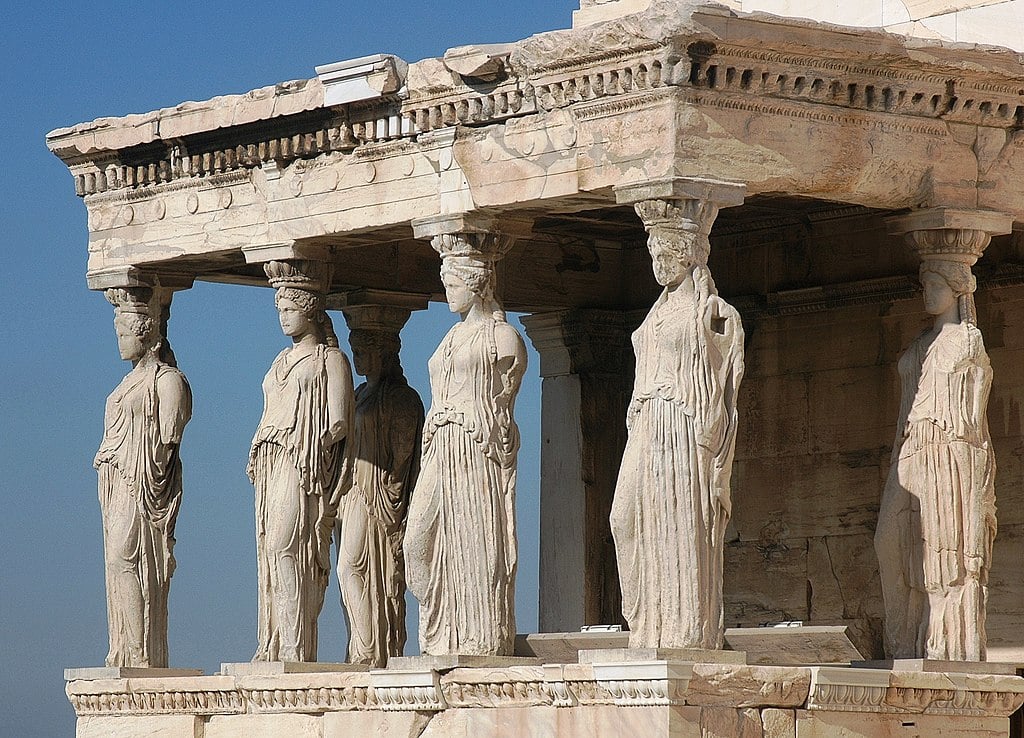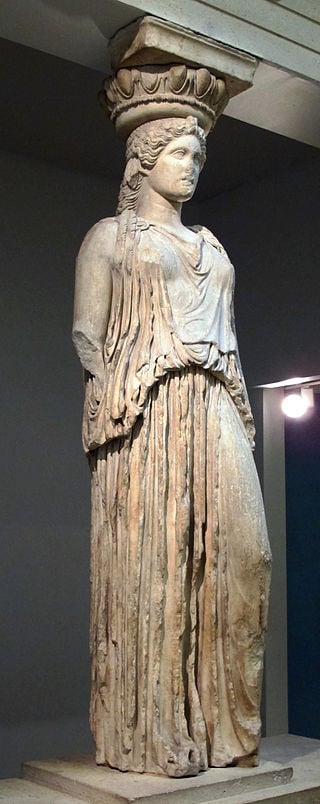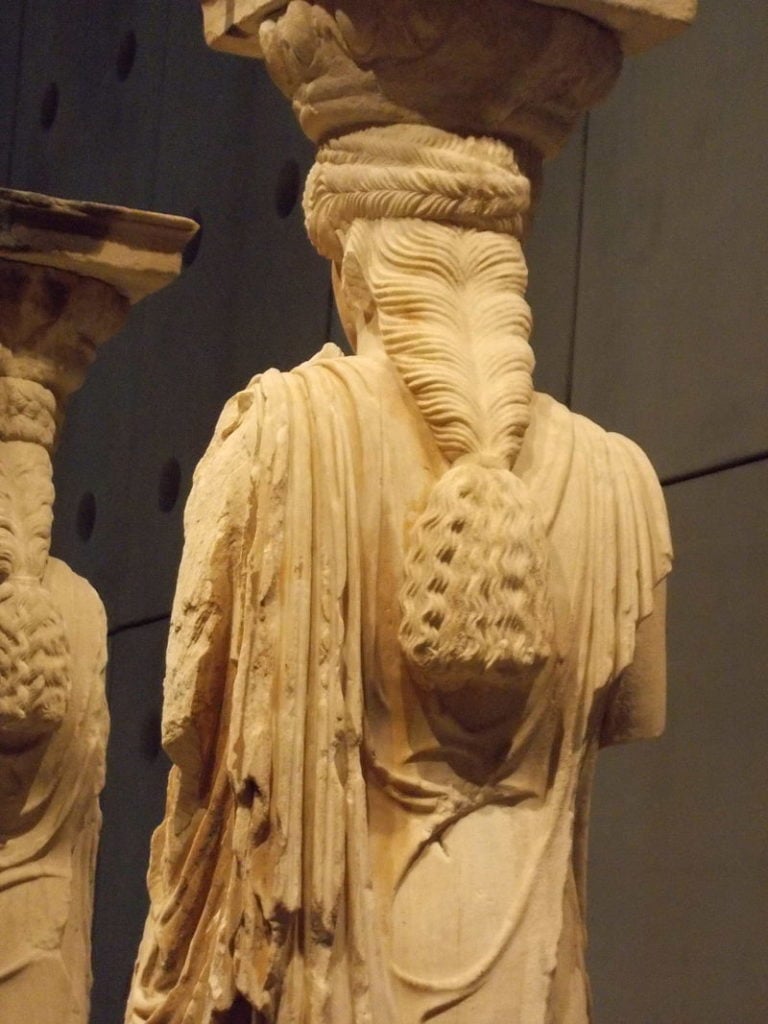

The Erechtheion, the ancient Greek temple held up by statues known as Caryatids, was dedicated to the gods Athena and Poseidon; it still stands on the Athens Acropolis, much like the Parthenon just meters away, as a testament to the glory of ancient Greece.
The stunningly beautiful marble building, constructed along the lines of the Ionic order, was considered the most sacred part of the Acropolis.
The southern roof of the Erechtheion is supported by six statues of maidens known as the Caryatids, which were created from 421 BC to 406 BC. An ancient inscription of the Erechtheion refers to the Caryatids simply as Korai (maidens) but the term karyatides means “maidens of Karyai,” which is an ancient town of Peloponnese.
An alternate version of the story is that the derivation of their name is from the young women of Sparta who danced every year in honor of the goddess Artemis Karyatis (“Artemis of the Walnut Tree”).
Sixth “sister” Caryatid in British Museum in London
The Caryatids which can currently be seen at the Erechtheum are faithful copies, since the five remaining originals are in the Acropolis Museum for their protection, conservation, and restoration.
But what about the sixth original Caryatid, you may ask? She was spirited away from her sisters in a brutal manner courtesy of Thomas Bruce, the seventh Lord Elgin, who served as Great Britain’s ambassador to the Ottoman Empire at the beginning of the nineteenth century.
It was none other than he who was responsible for chipping off the frieze sculptures known as the Parthenon Marbles from the façade of the nearby Parthenon, shipping them off to his homeland where they remain today.

The enormity of this cultural theft was so apparent even back in the very different world of 1802 that Elgin’s “gift” to the British government was hotly debated in Parliament, with many saying he had no moral grounds to remove these sculptures from their rightful place in Greece.
Eventually, however, they ended up in the British Museum where they remain in their windowless gallery even to this day.
Despite the heated protestations of a long string of government ministers, historians, and other experts from around the world, British Museum officials state they have every legal right to own the Marbles despite the fact that they were chipped off a building that is the embodiment of Greek history itself and they were taken at a time when Greece was occupied by a foreign power.
At a time when the “Decolonization” movement in museums is growing all over the world, it seems almost incomprehensible today that any of the Marbles, or the lone Caryatid, are still at the British Museum, separated from the illustrious homeland of their creation.
Caryatids’ grace, beauty unparalleled in art of sculpture

The beauty and grace of the Caryatids is truly something that must be witnessed in person, although photographs have been taken of them since the beginning of photography, and paintings were made by European artists after the modern nation of Greece was formed in the early 1800s.
The women, who appear to hold up the building by baskets on their heads to form the capitals of their columnar bodies, wear peplos, a simple tunic pinned on each shoulder. Their hair, as can be seen more easily close up on the statues in the Museum, is intricately braided, falling in luxuriant plaits down their backs.
The weight of the building appears to be borne on one leg of each of the Caryatids, encased in perpendicular folds arranged like the fluting of a column shaft. The other leg is flexed, creating a graceful, natural stance.
The Caryatids, made from Pentelic marble, resemble the women depicted in the east frieze of the Parthenon, which had just been completed when work on the Erechtheion began.

The nascent Greek state undertook the clearing away of Turkish dwellings from the sacred rock of the Acropolis, revealing the classical monuments of antiquity, in the early 1830s.
Of course, their fame had already spread in antiquity, and by Roman times the Caryatids were copied routinely, with almost identical sculptures placed in the Forum of Augustus and the Roman Pantheon, as well as at Hadrian’s Villa in Tivoli.
By the 16th century, caryatids became a fixture in the decorative arts in northern Europe as part of Northern Mannerism; by the early 17th century, Caryatid likenesses appeared in Jacobean interiors in England.
There are four terracotta caryatids on the porch of St. Pancras New Church, London, which was constructed in 1822.
How is the British Museum’s Caryatid sister faring?
According to Greek experts, the British Museum’s Caryatid sister is not faring well. Some say that the cleaning of the Caryatid in their possession was faulty, resulting in a change in her coloring. Naturally, neither she nor the Parthenon sculptures, made of pentelic marble, appear with their natural glow that was once imparted by the strong Greek sun.
But shown under the harsh fluorescent glare of the British Museum’s lighting, she looks not only out of place but darkly discolored as well, with none of the glow that is normally imparted by the marble, making for a resemblance that is akin to actual skin.
Measuring just over life size, at 2.28 meters (7.4 feet) she most likely held a sacrificial vessel in one of her missing hands. But what is in store for her in the future? Can the British Museum keep resisting all the clarion calls for her and the Parthenon Marbles’ return to their rightful home from where they were brutally stripped centuries ago?
That remains to be seen. But the tide may be turning for the repatriation of the missing Caryatid “sister” and her compatriots who once graced the façade of the Parthenon beside her.
Athens’ gleaming, state-of-the-art Acropolis Museum has left a space for the missing sister, hoping that the British Museum will return the lonely artifact.
As the creators of this short film, produced by JA Productions, say: “The weeping of the sixth marble daughter still echoes in the ears of the Greeks.”
